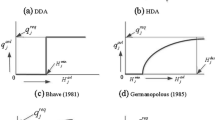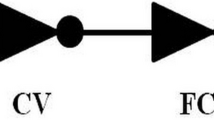Abstract
Generally, the water distribution networks are designed for peak demands so that under normal operating conditions pressure is adequate to meet the nodal demand however, due to this, the pressure remains excessive when the consumption is low. This leads to huge water leakages and pipe bursts due to excess available pressure. These excess of pressure can be reduced by operating pressure reducing valves. Moreover, the pressure deficient conditions of water distribution network depends on many factors such as excess demand (i.e., fire fighting demand), location and elevation of nodes, location and pressure setting values of pressure reducing valve, ageing of pipes (i.e., increase the pipe roughness) etc. In exceptional situations, pressure deficient condition also may occur when there is a fire demand while pressure reducing valves are in operating condition. The available literature of the pressure deficient condition as well as optimal location, number and their pressure setting values of pressure reducing valves are analysed by mathematical programming or optimization methods. Normally, it is cumbersome to the field engineers to use the any toolkit utility functions. Hence in this study, the pressure deficient condition is analysed via the method of modified pressure-deficient network algorithm without using EPANET toolkit functions which are coupled with pressure reducing valve operation. A benchmark problem is analysed and compared for the proposed method. Further, a real water distribution networks is analysed introducing fire demand at junction/distribution node using fixed and diurnal nodal demand pattern coupled with and without pressure reducing valve operation in a single hydraulic simulation.









Similar content being viewed by others
References
Andersen JH, Powell RS (1999) Simulation of water networks containing controlling elements. J Water Resour Plan and Manag 125(3):162–169
Ang WK, Jowitt PW (2006) Solution for water distribution systems under pressure-deficient conditions. J Water Resour Plan and Manag 132(3):175–182
Araujo LS, Ramos H, Coelho ST (2006) Pressure control for leakage minimization in water distribution systems management. Water Resour Manag 20(6):133–149
Babu KSJ, Mohan S (2012) Extended period simulation for pressure-deficient water distribution network. J Comput Civ Eng 26(4):498–505
Bhave PR (1981) Node flow analysis of water distribution systems. J Transp Eng 107(4):457–467
Bhave PR, Gupta R (2006) Analysis of water distribution networks. Narosa Publishing House Pvt Ltd, New Delhi
Campisano A, Modica C, Vetrano L (2012) Calibration of proportional controllers for the RTC of pressures to reduce leakage in water distribution networks. J Water Resour Plan Manag 138(4):377–384
Chandapillai J (1991) Realistic simulation of water distribution systems. J Transp Eng 117(2):258–263
Chandrashekar M (1980) Extended set of components in pipe networks. J Hydraul Div 106(HY1):133–149
Dai PD, Li P (2014) Optimal localization of pressure reducing valves in water distribution systems by a reformation approach. Water Resour Manag 28(10):3057–3074
Fietz TR (1977) Discussion of ‘pressure reducing valves in pipe network analysis’ by Jeppson RW, Davis AL. J Hydraul Res 11(2):123–136
Fujiwara O, Ganesharajah T (1993) Reliability assessment of water supply systems with storage and distribution networks. Water Resour Res 29(8):2917–2924
Germanopoulos G (1985) A technical note on the inclusion of pressure dependent demand and leakage terms in water supply network models. Civ Eng Syst 2(3):171–179
Germanopoulos G, Jowitt PW (1989) Leakage reduction by excess pressure minimisation in a water supply network. Proc Inst Civ Eng 2 Res Theory 87:195–214
Giustolisi O, Walski TM (2012) Demand components in water distribution network analysis. J Water Resour Plan Manag 138(4):356–367
Gomes R, Marques AS, Sousa J (2011) Estimation of the benefits yielded by pressure management in water distribution systems. Urban Water J 8(2):65–77
Guidolin M, Burovskiy P, Kapelan Z, Savic DA (2010) CWSNet: an object-oriented toolkit for water distribution system simulations. Proceedings of the 12th Annual Water Distribution Systems Analysis Conference, WDSA 2010, September 12–15, Tuscon, Arizona, USA
Gupta R, Bhave PR (1996) Comparison of methods for predicting deficient- network performance. J Water Resour Plan Manag 122(3):214–217
Hayuti M, Burrows R, Naga D (2007) Discussion of ‘solution for water distribution systems under pressure-deficient conditions’ by Ang WK, Jowitt PW. J Water Resour Plan Manag 133(6):570
Jeppson RW (1977) Analysis of flow in pipe networks. Ann Arbor Science, Ann Arbor
Jeppson RW, Davis AL (1976) Pressure reducing valves in pipe network analysis. J Hydraul Div 102(HY7):987–1001
Jeppson RW, Davis AL (1977) Closure to “pressure reducing valves in pipe network analysis”. J Hydraul Div 103(HY11):1362
Jowitt PW, Xu C (1990) Optimal valve control in water distribution networks. J Water Resour Plan and Manag 116(4):455–472
Jun L, Guoping Y (2013) Iterative methodology of pressure-dependent demand based on EPANET for pressure-deficient water distribution analysis. J Water Resour Plan and Manag 139(1):34–44
Kalungi P, Tanyimboh TT (2003) Redundancy model for water distribution systems. Reliability Eng Syst Saf 82:275–286
Kovalenko Y, Gorev NB, Kodzhespirova IF, Prokhorov E, Trapaga G (2014) Convergence of a hydraulic solver with pressure-dependent demands. Water Resour Manag 28(14):1013–1031
Liberatore S, Sechi G (2009) Location and calibration of valves in water distribution networks using a scatter search meta-heuristic approach. Water Resour Manag 23(8):1479–1495
Nicolini M, Giacomello C, Deb K (2011) Calibration and optimal leakage management for a real water distribution network. J Water Resour Plan and Manag 137(1):134–142
Pathirana A (2010) EPANET 2 desktop application for pressure driven demand modelling. Proceedings of the 12th Annual Water Distribution Systems Analysis Conference, WDSA 2010, September 12–15, Tuscon, Arizona, USA
Perez R, Martinez F, Vela A (1993) Improved design of branched networks by using pressure-reducing valves. J Hydraul Eng 119(2):164–180
Piller O, van Zyl JE (2014) Modeling control valves in water distribution systems using a continuous state formulation. J Hydraul Eng 04014052:1–9
Prescott SL, Ulanicki B (2003) Dynamic modelling of pressure reducing valves. J Hydraul Eng 129(10):804–812
Prescott SL, Ulanicki B (2008) Improved control of pressure reducing valves in water distribution networks. J Hydraul Eng 134(1):56–65
Reddy LS, Elango K (1989) Analysis of water distribution network with head dependent outlets. Civ Eng Syst 6(3):102–110
Reis LFR, Porto RM, Chaudhry FH (1997) Optimal location of control valves in pipe networks by genetic algorithms. J Water Resour Plan and Manag 123(6):317–326
Rossman LA (2000) EPANET 2 users manual, water supply and water resources division, National Risk Management Research Laboratory, U.S. Environmental Protection Agency, Cincinnati, Ohio
Rossman, LA (2000) EPANET 2 programmer’s toolkit manual, Water Supply and Water Resources Division, National Risk Management Research Laboratory, U.S. Environmental Protection Agency, Cincinnati, Ohio
Savic DA, Walters GA (1995) An evolution program for optimal pressure regulation in water distribution networks. Eng Optim 24:197–219
Siew C, Tanyimboh TT (2012) Pressure-dependent EPANET extension. Water Resour Manag 26(11):1477–1498
Sivakumar P, Prasad RK (2014) Simulation of water distribution network under pressure-deficient condition. Water Resour Manag 28(10):3271–3290
Vairavamoorthy K, Lumbers J (1998) Leakage reduction in water distribution systems: optimal valve control. J Hydraul Eng 124(11):1146–1154
Van Zyl JE, Borthwick J, Hardy A (2003) Ooten: an object-oriented programmers toolkit for epanet. Advances in water supply management (CCWI 2003), supplementary paper, 2003
Wagner JM, Shamir U, Marks DH (1988) Water distribution reliability: simulation methods. J Water Resour Plan and Manag 114(3):276–294
Wu ZY (2007) Discussion of ‘solution for water distribution systems under pressure-deficient conditions’ by Ang WK, Jowitt PW. J Water Resour Plan and Manag 133(6):567–568
Author information
Authors and Affiliations
Corresponding author
Rights and permissions
About this article
Cite this article
Sivakumar, P., Prasad, R.K. Extended Period Simulation of Pressure-Deficient Networks Using Pressure Reducing Valves. Water Resour Manage 29, 1713–1730 (2015). https://doi.org/10.1007/s11269-014-0907-5
Received:
Accepted:
Published:
Issue Date:
DOI: https://doi.org/10.1007/s11269-014-0907-5




